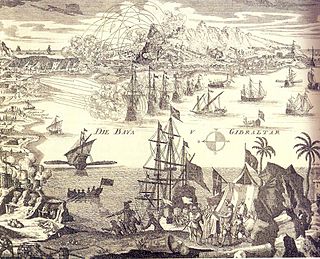
The War of the Austrian Succession was a European conflict that took place between 1740 and 1748. Fought primarily in Central Europe, the Austrian Netherlands, Italy, the Atlantic and Mediterranean, related conflicts included King George's War in North America, the War of Jenkins' Ear, the First Carnatic War and the First and Second Silesian Wars.

Thomas Pelham-Holles, 1st Duke of Newcastle upon Tyne and 1st Duke of Newcastle-under-Lyne, was an English Whig statesman who served as Prime Minister of Great Britain, his official life extended throughout the Whig supremacy of the 18th century. He is commonly known as the Duke of Newcastle.

The Treaty of Hubertusburg was signed on 15 February 1763 at Hubertusburg Castle by Prussia, Austria and Saxony to end the Third Silesian War. Together with the Treaty of Paris, signed five days earlier, it marked the end of the Seven Years' War. The treaty ended the continental conflict with no significant changes in prewar borders. Austria and Saxony renounced all claims to the Silesian territories ceded to Prussia in the 1742 Treaty of Berlin and the 1745 Treaty of Dresden. Prussia clearly stood among the ranks of the European great powers, while the treaty enhanced the rivalry with Austria.

Count Alexey Petrovich Bestuzhev-Ryumin was a Russian diplomat and chancellor. He was one of the most influential and successful diplomats in 18th-century Europe. As the chancellor of the Russian Empire was chiefly responsible for Russian foreign policy during the reign of Empress Elizaveta Petrovna.

The Silesian Wars were three wars fought in the mid-18th century between Prussia and Habsburg Austria for control of the Central European region of Silesia. The First (1740–1742) and Second (1744–1745) Silesian Wars formed parts of the wider War of the Austrian Succession, in which Prussia was a member of a coalition seeking territorial gain at Austria's expense. The Third Silesian War (1756–1763) was a theatre of the global Seven Years' War, in which Austria in turn led a coalition of powers aiming to seize Prussian territory.

The Treaty of Seville was signed on 9 November 1729 between Britain, France, and Spain, formally ending the 1727–1729 Anglo-Spanish War; the Dutch Republic joined the Treaty on 29 November.

The Second Silesian War was a war between Prussia and Austria that lasted from 1744 to 1745 and confirmed Prussia's control of the region of Silesia. The war was fought mainly in Silesia, Bohemia, and Upper Saxony and formed one theatre of the wider War of the Austrian Succession. It was the second of three Silesian Wars fought between Frederick the Great's Prussia and Maria Theresa's Austria in the mid-18th century, all three of which ended in Prussian control of Silesia.

The 1748 Treaty of Aix-la-Chapelle, sometimes called the Treaty of Aachen, ended the War of the Austrian Succession, following a congress assembled on 24 April 1748 at the Free Imperial City of Aachen.

The Diplomatic Revolution of 1756 was the reversal of longstanding alliances in Europe between the War of the Austrian Succession and the Seven Years' War. Austria went from an ally of Britain to an ally of France, the Dutch Republic, a long-standing British ally, became more anti-British and took a neutral stance, while Prussia became an ally of Britain. The most influential diplomat involved was an Austrian statesman, Wenzel Anton von Kaunitz.

The term French–Habsburg rivalry describes the rivalry between France and the House of Habsburg. The Habsburgs headed an expansive and evolving Empire that included, at various times, the Holy Roman Empire, the Spanish Empire, Austria, Bohemia and Hungary from the Diet of Augsburg in the High Middle Ages until the dissolution of the monarchy following World War I in the late modern period.

The 1731 Treaty of Vienna was signed on 16 March 1731 between Great Britain and Emperor Charles VI on behalf of the Habsburg monarchy, with the Dutch Republic included as a party.

The Seven Years' War (1756–1763) was a global conflict that involved most of the European great powers, and was fought primarily in Europe, the Americas, and Asia-Pacific. Other concurrent conflicts include the French and Indian War (1754–1763), the Carnatic Wars (1744–1763) and the Anglo-Spanish War (1762–1763). The opposing alliances were led by Great Britain and France respectively, both seeking to establish global pre-eminence at the expense of the other. Along with Spain, France fought Britain both in Europe and overseas with land-based armies and naval forces, while Britain's ally Prussia sought territorial expansion in Europe and consolidation of its power. Long-standing colonial rivalries pitting Britain against France and Spain in North America and the West Indies were fought on a grand scale with consequential results. Prussia sought greater influence in the German states, while Austria wanted to regain Silesia, captured by Prussia in the previous war, and to contain Prussian influence.
The Anglo-French Alliance is the name for the alliance between Great Britain and France between 1716 and 1731. It formed part of the stately quadrille in which the Great Powers of Europe repeatedly switched partners to try to build a superior alliance.
The stately quadrille is the name given to set of constantly shifting alliances between the great powers of Europe during the 18th century. The ultimate objective was to maintain the balance of power in Europe to stop any one alliance or country becoming too strong. It takes its name from the quadrille, a dance in which the participants constantly swap partners.

Great Britain was one of the major participants in the Seven Years' War, which in fact lasted nine years, between 1754 and 1763. British involvement in the conflict began in 1754 in what became known as the French and Indian War. However the warfare in the European theater involving countries other than Britain and France commenced in 1756. Britain emerged from the war as the world's leading colonial power, having gained all of New France in North America, ending France's role as a colonial power there. Following Spain's entry in the war in alliance with France in the third Family Compact, Britain captured the major Spanish ports of Havana, Cuba and Manila, in the Philippines in 1762, and agreed to return them in exchange for Spanish Florida. The Treaty of Paris in 1763 formally ended the conflict and Britain established itself as the world's pre-eminent naval power.

The Anglo-Prussian Alliance was a military alliance created by the Westminster Convention between Great Britain and Prussia that lasted formally between 1756 and 1762, during the Seven Years' War. The alliance allowed Britain to concentrate most of its efforts against the colonial possessions of the French-led coalition while Prussia was bearing the brunt of the fighting in Europe. It ended in the final months of the conflict, but strong ties between both kingdoms remained.

The Franco-Austrian Alliance was a diplomatic and military alliance between France and Austria that was first established in 1756 after the First Treaty of Versailles. It lasted for much of the remainder of the century until it was abandoned during the French Revolution.
The Treaty of Versailles, also known as the First Treaty of Versailles, was a diplomatic agreement between France and Austria. It was signed in 1756 at the Palace of Versailles in France. There were four treaties signed on this Agreement.

The Treaty of Versailles was a diplomatic agreement signed between Austria and France at the Palace of Versailles on 1 May 1757 during the Seven Years' War. It expanded on the 1756 First Treaty of Versailles, which had established the Franco-Austrian Alliance. It is thus commonly known as the Second Treaty of Versailles.
The Anglo-Prussian Convention was agreed on 11 April 1758 between Great Britain and the Kingdom of Prussia formalising the alliance between them that had effectively existed since the Convention of Westminster in 1756.



















